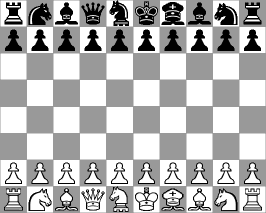Gothic chess
Gothic Chess is a commercially exploited variant of chess on the extended 10 × 8 chess board.
history
Gothic Chess is a variation of the 10 × 8 ( Capablanca ) chess, which is probably based on an idea by Pietro Carrera (1617) to pair the basic gaits of knight, bishop and rook in three types of figures on a correspondingly enlarged 10 × 8 chess board combine. The idea, revived by Henry Bird in 1874, was taken up again by José Raúl Capablanca (world chess champion 1921 to 1927) and was finalized in 1940. Ed Trice changed the starting line-up according to his own optimality criteria and applied for a patent in 2001 for a "Method of playing a variant of chess" in the USA : This was published on November 19, 2002 under the number US6481716, but is on January 16 Expired in 2007; a corresponding patent application in Europe under number EP1236486 was withdrawn on December 3, 2003. In addition to Gothic Chess, there is also a 10 × 8 chess variant, Janusschach , which is better known in Germany .
Standard supplements to traditional chess
|
||||||||||||||||||||||||||||||||||||||||||||||||||||||||||||||||||||||||||||||||||||||||||||||||||||||||||||||||||||||||
| Gothic Chess (starting grid, USA patent) |
As a 10 × 8 chess, Gothic Chess largely integrates the rules of traditional chess. Experienced chess players are basically familiar with the new pieces and their possibilities after about a week of daily play. The following additions must be observed (in addition to the starting grid):
- it is played on a board with 10 × 8 (width times height) fields
- There are two additional types of figures used (but not yet a symbol standard - see pictures a and b):
- the chancellor (on line e) - how to move rook or knight
- the archbishop (on line g, also Janus or cardinal ) - to move like jumper or bishop
- Abbreviations used: 'Z' (for Chancellor, English 'C') and 'E' (for Archbishop, English 'A')
- a farmer can also be converted into the new types during his doctorate
- castling moves the king 3 steps in the direction of the roaring tower
- The PGN format in combination with X-FEN is used to save games
The Gothic Chess starting line-up could formally also be one of Capablanca Random Chess (in which the respective sequence of figures is drawn according to certain rules). For reasons of patenting, however, it remains excluded from its 12,118 possibilities.
Course of the game, strategy, figure value and combinations
The starting line-up of Gothic Chess should avoid possible traps during the opening phase due to unprotected pawns and insecure pieces and thereby also keep White's draw advantage low.
The figures vary even more than in traditional chess, depending on the game phase and position. Nevertheless, one can orientate oneself on the following, theoretically derived values of two competing models:
- Ed Trice: pawn 1, knight 2.5, bishop 3, rook 4.75, archbishop 6.5, chancellor 8.25, queen 8.75
- R. Scharnagl: pawn 1, knight 3, bishop 3½, rook 5½, archbishop 6¾, chancellor 8¾, lady 9½
- rough equivalences: B + B + B ≈ S, S + L ≈ B + T, B + S + S ≈ L + L, B + E + E ≈ L + T + T, B + Z ≈ S + E, E + Z ≈ S + S + D, B + S + T ≈ S + S + L ≈ D
The constantly present tactical entanglements can be a problem for beginners, but can be mastered by the vast majority of players. Especially in the complex interplay of different figure types, surprising scenarios arise again and again. Incidentally, the early exchange of the queen does not lead to a higher draw rate among similarly strong players.
Endgame
The Gothic endgames are longer than the comparable endgames in classic chess. The output is usually transferable. In the case of the other pieces, the cardinal, who always wins in the elementary endgame against the bishop, could win after 72 moves at the latest if the 50-move rule did not apply. King and Cardinal always wins against King and Knight in 36 moves, although both finals are very difficult to play. The queen cannot win against the cardinal or against the chancellor (and otherwise only kings) in general. Here, too, there are exceptional positions with up to 31 or 27 moves to ensure mate. The currently longest known endgame is that of king, queen and pawn against king and queen with mate in 268 moves.
Chess programs for Gothic Chess
Due to an existing patent in the USA for Gothic chess, it is up to the user to set up the starting line-up in programs by other authors (once) by hand and, if necessary, to save it for further use. Because programmed automatisms would possibly require a license there.
All three of the most famous Gothic-Chess capable programs play at a high level. The commercial Gothic Vortex also includes an extensive opening and endgame database. It is also available as a weakened, free trial version. The free program ChessV offers u. a. numerous 8 × 8 and 10 × 8 chess variants, as well as the SMIRF donationware program, which is especially dedicated to Capablanca Random Chess , the improved bonus version of which is reserved for donors. Strong players are able to beat such 10 × 8 programs.
Web links
- gothicchess.com ( Memento from April 27, 2006 in the Internet Archive ) - Gothic Chess Federation (English)
- Database for Gothic Chess endgames (German)
Individual evidence
- ↑ Family Legal Status Report on US6481716 in the Delphion patent database www.delphion.com


